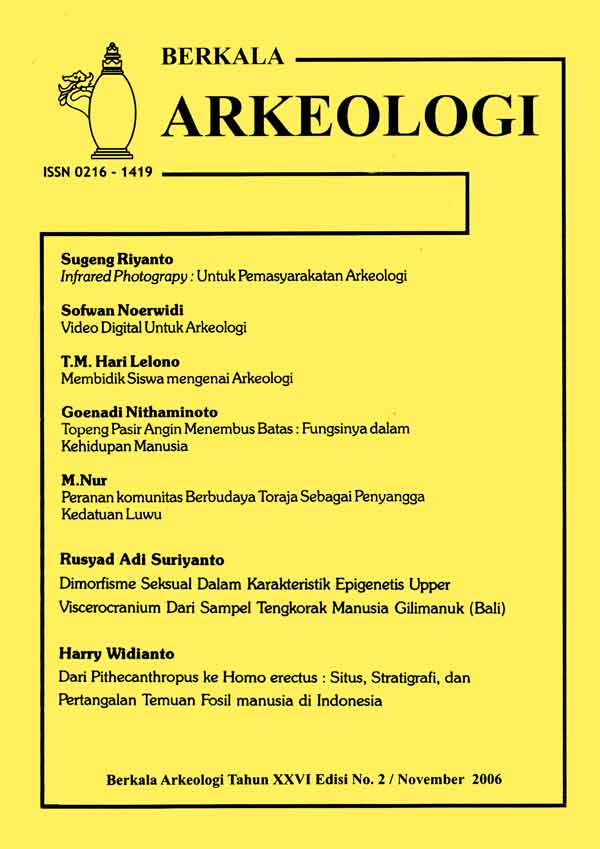DARI PITHECANTHROPUS KE HOMO ERECTUS: SITUS, STRATIGRAFI, DAN PERTANGGALAN TEMUAN FOSIL MANUSIA DI INDONESIA
Main Article Content
Abstract
More than 100 ancient human individuals were shown from various ancient deposits on the island of Java, whose sites are located in various physiographic landscapes, namely: the Solo basin (Sangiran and Miri), the volcanic deposits of the Kendeng Mountains (Trinil, Kedungbrubus, and Perning in Mojokerto), the Bengawan Solo alluvial deposits (Ngandong, Sambungmacan, and Ngawi), and the volcanic deposits of Mount Muria (Patiayam). Human migration on the island of Java is thought to have only taken place in the Lower Plestocene from mainland Asia, which probably originated in Africa.
Article Details

This work is licensed under a Creative Commons Attribution-NonCommercial-ShareAlike 4.0 International License.
References
Bartstra, Gert-Jan, Santoso Sugondho & Albert van der Wijk, "Ngandong man, age and artifacts", Journal of Human Evolution, 17, 1988, hal. 325-337;
Campbell, B.G, 1965. “The nomenclature of the Hominidaeâ€, Royal Anthrop. Inst Of Great Britain and Ireland : hal 1-28.
De Terra, H., 1943. “Pleistocene geology on early man in Javaâ€, Trans. Of the Americ. Phil. Soc., Vol. XXXII: 437-466.
De Vos, John, et al., 1982. “The importance of the Dubois collection reconsideredâ€, Mod. Quatern. Res. In SE Asia, 7 : 35-63.
Duyfjes, J., 1936. “Zur geologie und stratigraphie des Kendenggebietes zwischen Trinil und Soerabaja (Java)â€, De Ingenieur in Nederlandsch lndie, 8: 136-149.
Howells, W.W., 1973. Evolution of the genus Homo, 188 hal.
Jacob, T., 1984. « The fossil skull cup from Sambungmachan and its implication to human evolution», Berkala Bioanthropologi Indonesia V (1): 19-29.
Jacob, T., and GH Curtis, 1971. “Preliminary pottassium argon dating of early man in Javaâ€, Contr. Un. Calif. Archaeolo. Res. Facil., 12: 50.
Koenigswald, GH.R, von, 1940. “Neue Pithecanthropusfunde 1936-1938. Ein beitrag zur kenntnis der praehominidenâ€, Wetensch. Medel., 28: 1-205.
Marks, P., 1953. “Preliminary note on the discovery of a new jaw of Meganthropus von Koenigswald in the Lower-Middle Pleistocene of Sangiran, Central Java, lndonesiaâ€, Journ. Natur. Sci., 109 : 26-33.
Mayr, E., 1950. "Taxonomic categories in fossil hominids", Cold Spring Harbor Symposia on Quantitative Biology, 25 : Origin and Evolution of Man: 109-118.
Oppenoorth, W.F.F., 1932. “Homo (javanthropus) soloensis, een Plistocene mensch van Javaâ€, Wetensch. Med. Dienst Mijnb. Ned. lndie, 20: 49-74.
Sartono, S., 1991. "New Homo erectus skull from Ngawi, East Java : relation to Upper Pleistocene terraces in Java", lndo-Pacific Prehistory Association, no.11 : 14-22.
Semah. A.M, 1982. “Variation de la vegetation du Plio-Pleistocene sur les sites de Sangiran et Sambungmacan (Java Central) par I 'analyse polliniqueâ€, Premier Congres International de Paleontolagie Humaine : 559-577 ;
Semah, A.M., 1986. “Le millieu naturel lors du premiers peuplement de Java, resultats de I 'analyse pollinique“, These de Doctorates= Science Naturelles, Vol. I et Il : 189 hal.
Semah, F., 1986. “Le peuplement ancien de Java. Ebouch d'un cadre chronologiqueâ€, L’Anthropologie Tome 90, No. 3 : hal. 359-400.
Semah, F.,A-M. Semah, Tony Djubiantono, Mereka Menemukan Pulau Jawa, Jakarta: Puslit Arkenas, 1990, hal. 19.
Suzuki. M., et al., 1982. “A chronological framing for the Sangiran hominids-fundamental study by the flourine dating methodâ€, Bull. Nat. Sci. Mus. Tokyo, D, 8: hal. 1-53.
Swisher III, C.C, W.J. Rink, S.C. Anton, H.P. Schwarcz, GH. Curtis, A. Suprijo, Widiasmoro, 1996. "Latest Homo erectus of Java: Potential contemporaneity with Homo sapiens in Southeast Asia", Science, vol. 274: hal. 1870-1873.
Swisher ill, C.C., GH Curtis, T. Jacob, A.G Getty, A. Suprijo, Widiasmoro, 1994. "Age of the earliest known hominids in Java, Indonesia", Science,25February 1994: 1118-1121.
Van Es, L.J.C, 1931. The Age of the Pithecanthropus, 141 hal.
Weidenreich, F., 1945. “Giant early man from Java and South Chinaâ€, Anthrop. Papers Am. Mus. Nat. Hist. 40 : 205-290.
Widianto, Harry, 1993. "Unite et Diversite des Homindes Fossiles de Java: Presentation de Restes Humains Fossiles Inedits ", Desertasi. Institut de Paleeontologie Humaine, Paris, Perancis, 284 hal.
Widianto, Harry and V. Zeitoun, 2003. "Morphological description, biometry, and phylogenetic position of the skull of Ngawi 1 (East Java, Indonesia)", International Journal of Osteoarchaeology, 13 : 339-351.
Widianto, Harry, A.M Semah, T. Djubiantono, and F. Semah, 1994. “A tentative reconstruction of human cranial remains of Hanoman 1 from Bukuran, Sangiran, Indonesia†Cour. Forsch. Ins.
Sancken berg; Vol 171 : 47-59.
Widianto, Harry, D. Grimaud-Herve, S. Sartono, 2001. "The evolutionary position of the Ngawi calvaria ", In do-Pacific Prehistory Association Bulletin 21 : 162.
Widianto, Harry, T. Simanjuntak, and Budianto Toha, 2001. “The discovery of stone implements in the grenzbank : new insights into the chronology of the Sangiran flake industry†Bull. of the IndoPacific Prehistory Association, Vol 21 : 159-161.
Zaim, M. Y., 1989. "Les formations volcano-sedimentaires quaternaries de la region de Patiayam, Central Java, Indoneesie. Milieu de sedimentation et mineralogy", These de Doctorat du Museum National d'Histoire Naturelle, Paris: 264 hal.

